Articles and Their Annotated Bibliography
VerifiedAdded on 2023/03/21
|7
|1575
|79
AI Summary
This annotated bibliography discusses the adverse effects of excessive use of digital media on children and adolescents, as well as the consequences of digital disruption on workers and society. It provides relevant information and case studies, highlighting the need for proper management and skilled workers in the digital era.
Contribute Materials
Your contribution can guide someone’s learning journey. Share your
documents today.
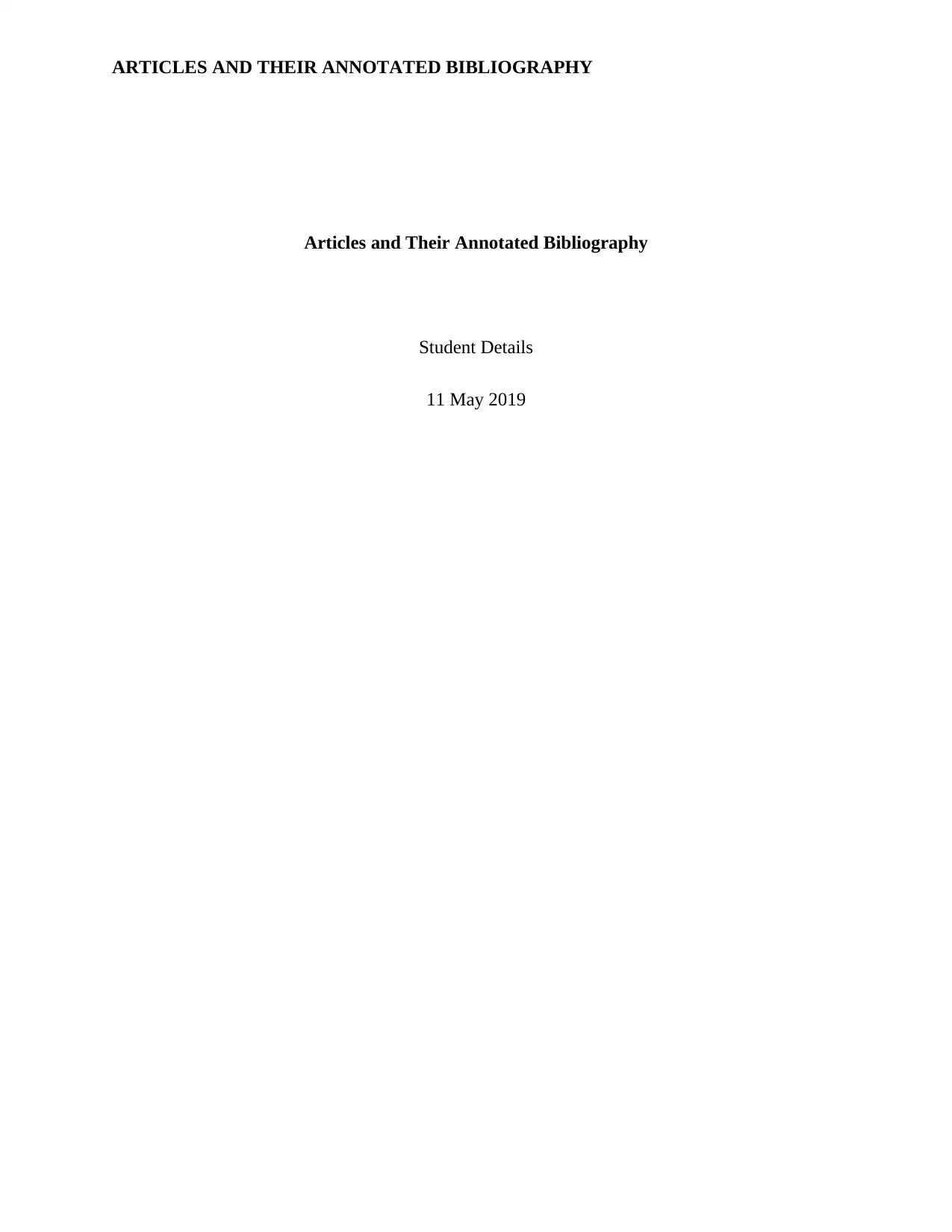
ARTICLES AND THEIR ANNOTATED BIBLIOGRAPHY
Articles and Their Annotated Bibliography
Student Details
11 May 2019
Articles and Their Annotated Bibliography
Student Details
11 May 2019
Secure Best Marks with AI Grader
Need help grading? Try our AI Grader for instant feedback on your assignments.
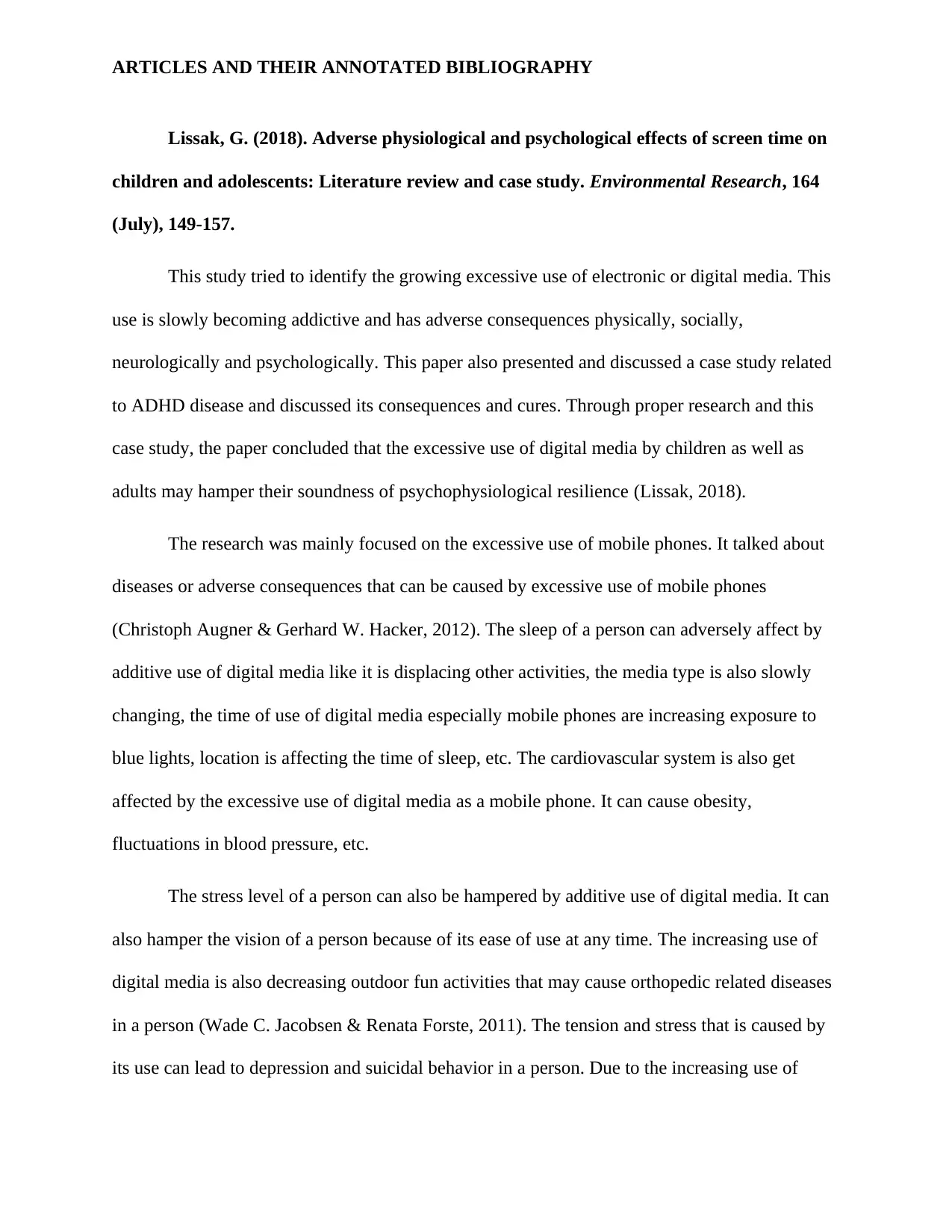
ARTICLES AND THEIR ANNOTATED BIBLIOGRAPHY
Lissak, G. (2018). Adverse physiological and psychological effects of screen time on
children and adolescents: Literature review and case study. Environmental Research, 164
(July), 149-157.
This study tried to identify the growing excessive use of electronic or digital media. This
use is slowly becoming addictive and has adverse consequences physically, socially,
neurologically and psychologically. This paper also presented and discussed a case study related
to ADHD disease and discussed its consequences and cures. Through proper research and this
case study, the paper concluded that the excessive use of digital media by children as well as
adults may hamper their soundness of psychophysiological resilience (Lissak, 2018).
The research was mainly focused on the excessive use of mobile phones. It talked about
diseases or adverse consequences that can be caused by excessive use of mobile phones
(Christoph Augner & Gerhard W. Hacker, 2012). The sleep of a person can adversely affect by
additive use of digital media like it is displacing other activities, the media type is also slowly
changing, the time of use of digital media especially mobile phones are increasing exposure to
blue lights, location is affecting the time of sleep, etc. The cardiovascular system is also get
affected by the excessive use of digital media as a mobile phone. It can cause obesity,
fluctuations in blood pressure, etc.
The stress level of a person can also be hampered by additive use of digital media. It can
also hamper the vision of a person because of its ease of use at any time. The increasing use of
digital media is also decreasing outdoor fun activities that may cause orthopedic related diseases
in a person (Wade C. Jacobsen & Renata Forste, 2011). The tension and stress that is caused by
its use can lead to depression and suicidal behavior in a person. Due to the increasing use of
Lissak, G. (2018). Adverse physiological and psychological effects of screen time on
children and adolescents: Literature review and case study. Environmental Research, 164
(July), 149-157.
This study tried to identify the growing excessive use of electronic or digital media. This
use is slowly becoming addictive and has adverse consequences physically, socially,
neurologically and psychologically. This paper also presented and discussed a case study related
to ADHD disease and discussed its consequences and cures. Through proper research and this
case study, the paper concluded that the excessive use of digital media by children as well as
adults may hamper their soundness of psychophysiological resilience (Lissak, 2018).
The research was mainly focused on the excessive use of mobile phones. It talked about
diseases or adverse consequences that can be caused by excessive use of mobile phones
(Christoph Augner & Gerhard W. Hacker, 2012). The sleep of a person can adversely affect by
additive use of digital media like it is displacing other activities, the media type is also slowly
changing, the time of use of digital media especially mobile phones are increasing exposure to
blue lights, location is affecting the time of sleep, etc. The cardiovascular system is also get
affected by the excessive use of digital media as a mobile phone. It can cause obesity,
fluctuations in blood pressure, etc.
The stress level of a person can also be hampered by additive use of digital media. It can
also hamper the vision of a person because of its ease of use at any time. The increasing use of
digital media is also decreasing outdoor fun activities that may cause orthopedic related diseases
in a person (Wade C. Jacobsen & Renata Forste, 2011). The tension and stress that is caused by
its use can lead to depression and suicidal behavior in a person. Due to the increasing use of
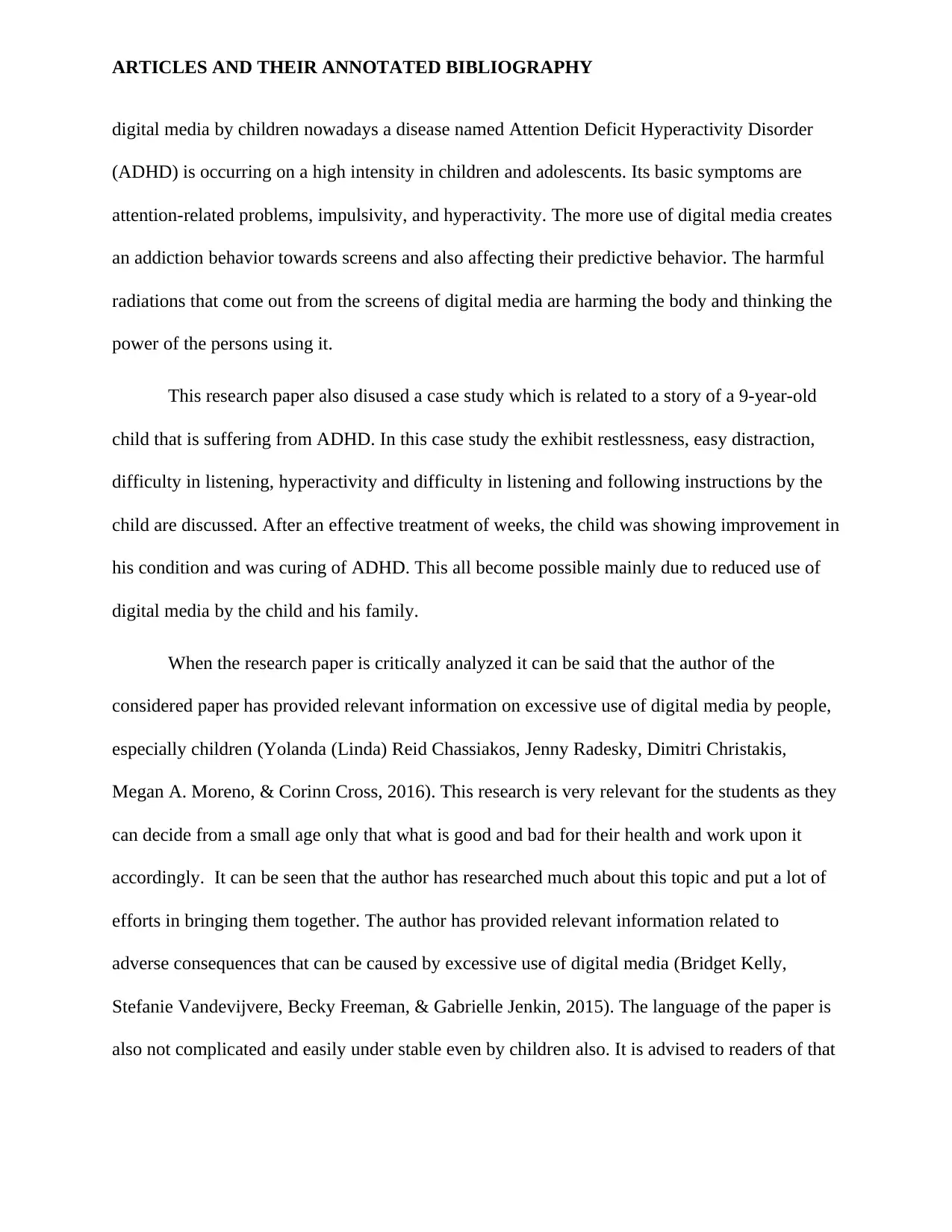
ARTICLES AND THEIR ANNOTATED BIBLIOGRAPHY
digital media by children nowadays a disease named Attention Deficit Hyperactivity Disorder
(ADHD) is occurring on a high intensity in children and adolescents. Its basic symptoms are
attention-related problems, impulsivity, and hyperactivity. The more use of digital media creates
an addiction behavior towards screens and also affecting their predictive behavior. The harmful
radiations that come out from the screens of digital media are harming the body and thinking the
power of the persons using it.
This research paper also disused a case study which is related to a story of a 9-year-old
child that is suffering from ADHD. In this case study the exhibit restlessness, easy distraction,
difficulty in listening, hyperactivity and difficulty in listening and following instructions by the
child are discussed. After an effective treatment of weeks, the child was showing improvement in
his condition and was curing of ADHD. This all become possible mainly due to reduced use of
digital media by the child and his family.
When the research paper is critically analyzed it can be said that the author of the
considered paper has provided relevant information on excessive use of digital media by people,
especially children (Yolanda (Linda) Reid Chassiakos, Jenny Radesky, Dimitri Christakis,
Megan A. Moreno, & Corinn Cross, 2016). This research is very relevant for the students as they
can decide from a small age only that what is good and bad for their health and work upon it
accordingly. It can be seen that the author has researched much about this topic and put a lot of
efforts in bringing them together. The author has provided relevant information related to
adverse consequences that can be caused by excessive use of digital media (Bridget Kelly,
Stefanie Vandevijvere, Becky Freeman, & Gabrielle Jenkin, 2015). The language of the paper is
also not complicated and easily under stable even by children also. It is advised to readers of that
digital media by children nowadays a disease named Attention Deficit Hyperactivity Disorder
(ADHD) is occurring on a high intensity in children and adolescents. Its basic symptoms are
attention-related problems, impulsivity, and hyperactivity. The more use of digital media creates
an addiction behavior towards screens and also affecting their predictive behavior. The harmful
radiations that come out from the screens of digital media are harming the body and thinking the
power of the persons using it.
This research paper also disused a case study which is related to a story of a 9-year-old
child that is suffering from ADHD. In this case study the exhibit restlessness, easy distraction,
difficulty in listening, hyperactivity and difficulty in listening and following instructions by the
child are discussed. After an effective treatment of weeks, the child was showing improvement in
his condition and was curing of ADHD. This all become possible mainly due to reduced use of
digital media by the child and his family.
When the research paper is critically analyzed it can be said that the author of the
considered paper has provided relevant information on excessive use of digital media by people,
especially children (Yolanda (Linda) Reid Chassiakos, Jenny Radesky, Dimitri Christakis,
Megan A. Moreno, & Corinn Cross, 2016). This research is very relevant for the students as they
can decide from a small age only that what is good and bad for their health and work upon it
accordingly. It can be seen that the author has researched much about this topic and put a lot of
efforts in bringing them together. The author has provided relevant information related to
adverse consequences that can be caused by excessive use of digital media (Bridget Kelly,
Stefanie Vandevijvere, Becky Freeman, & Gabrielle Jenkin, 2015). The language of the paper is
also not complicated and easily under stable even by children also. It is advised to readers of that
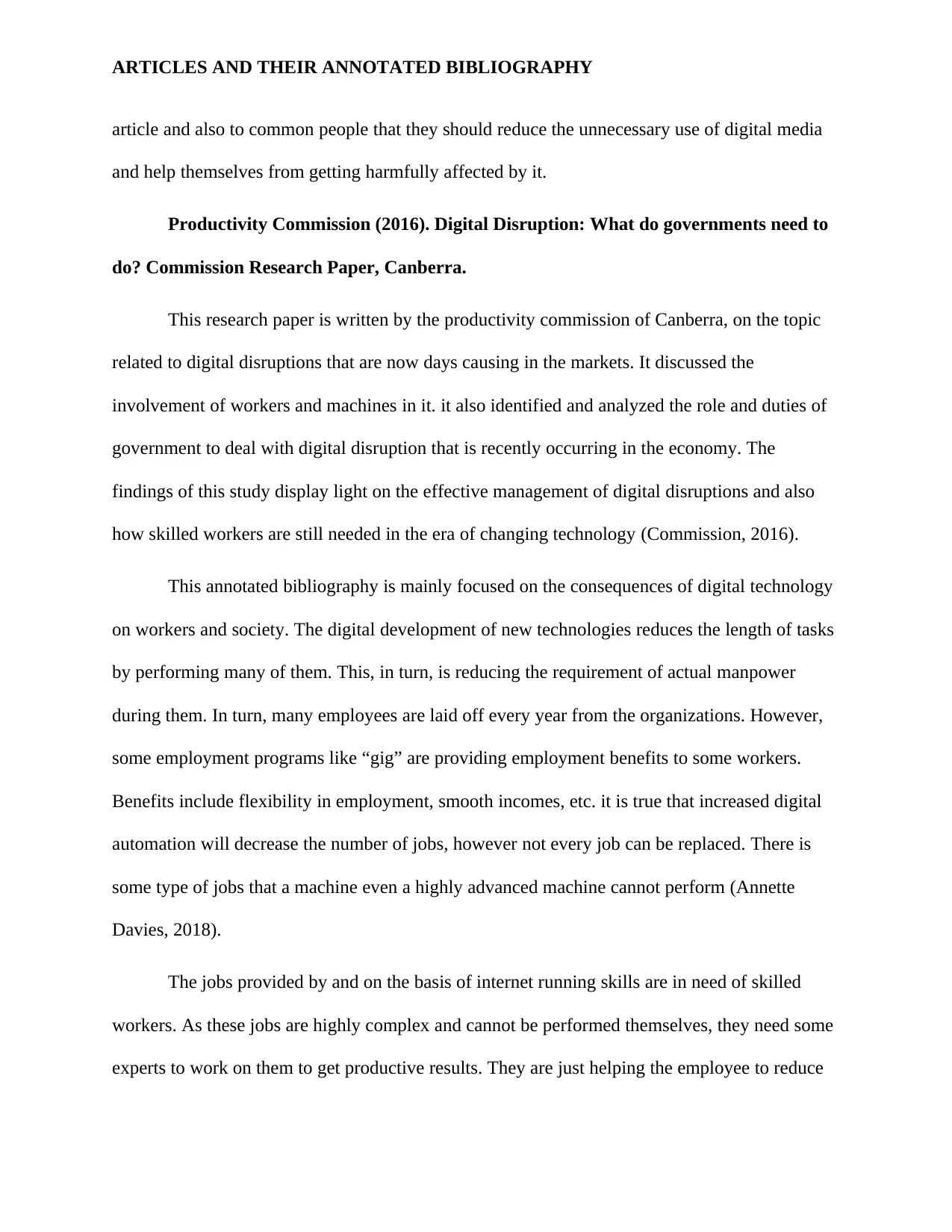
ARTICLES AND THEIR ANNOTATED BIBLIOGRAPHY
article and also to common people that they should reduce the unnecessary use of digital media
and help themselves from getting harmfully affected by it.
Productivity Commission (2016). Digital Disruption: What do governments need to
do? Commission Research Paper, Canberra.
This research paper is written by the productivity commission of Canberra, on the topic
related to digital disruptions that are now days causing in the markets. It discussed the
involvement of workers and machines in it. it also identified and analyzed the role and duties of
government to deal with digital disruption that is recently occurring in the economy. The
findings of this study display light on the effective management of digital disruptions and also
how skilled workers are still needed in the era of changing technology (Commission, 2016).
This annotated bibliography is mainly focused on the consequences of digital technology
on workers and society. The digital development of new technologies reduces the length of tasks
by performing many of them. This, in turn, is reducing the requirement of actual manpower
during them. In turn, many employees are laid off every year from the organizations. However,
some employment programs like “gig” are providing employment benefits to some workers.
Benefits include flexibility in employment, smooth incomes, etc. it is true that increased digital
automation will decrease the number of jobs, however not every job can be replaced. There is
some type of jobs that a machine even a highly advanced machine cannot perform (Annette
Davies, 2018).
The jobs provided by and on the basis of internet running skills are in need of skilled
workers. As these jobs are highly complex and cannot be performed themselves, they need some
experts to work on them to get productive results. They are just helping the employee to reduce
article and also to common people that they should reduce the unnecessary use of digital media
and help themselves from getting harmfully affected by it.
Productivity Commission (2016). Digital Disruption: What do governments need to
do? Commission Research Paper, Canberra.
This research paper is written by the productivity commission of Canberra, on the topic
related to digital disruptions that are now days causing in the markets. It discussed the
involvement of workers and machines in it. it also identified and analyzed the role and duties of
government to deal with digital disruption that is recently occurring in the economy. The
findings of this study display light on the effective management of digital disruptions and also
how skilled workers are still needed in the era of changing technology (Commission, 2016).
This annotated bibliography is mainly focused on the consequences of digital technology
on workers and society. The digital development of new technologies reduces the length of tasks
by performing many of them. This, in turn, is reducing the requirement of actual manpower
during them. In turn, many employees are laid off every year from the organizations. However,
some employment programs like “gig” are providing employment benefits to some workers.
Benefits include flexibility in employment, smooth incomes, etc. it is true that increased digital
automation will decrease the number of jobs, however not every job can be replaced. There is
some type of jobs that a machine even a highly advanced machine cannot perform (Annette
Davies, 2018).
The jobs provided by and on the basis of internet running skills are in need of skilled
workers. As these jobs are highly complex and cannot be performed themselves, they need some
experts to work on them to get productive results. They are just helping the employee to reduce
Secure Best Marks with AI Grader
Need help grading? Try our AI Grader for instant feedback on your assignments.
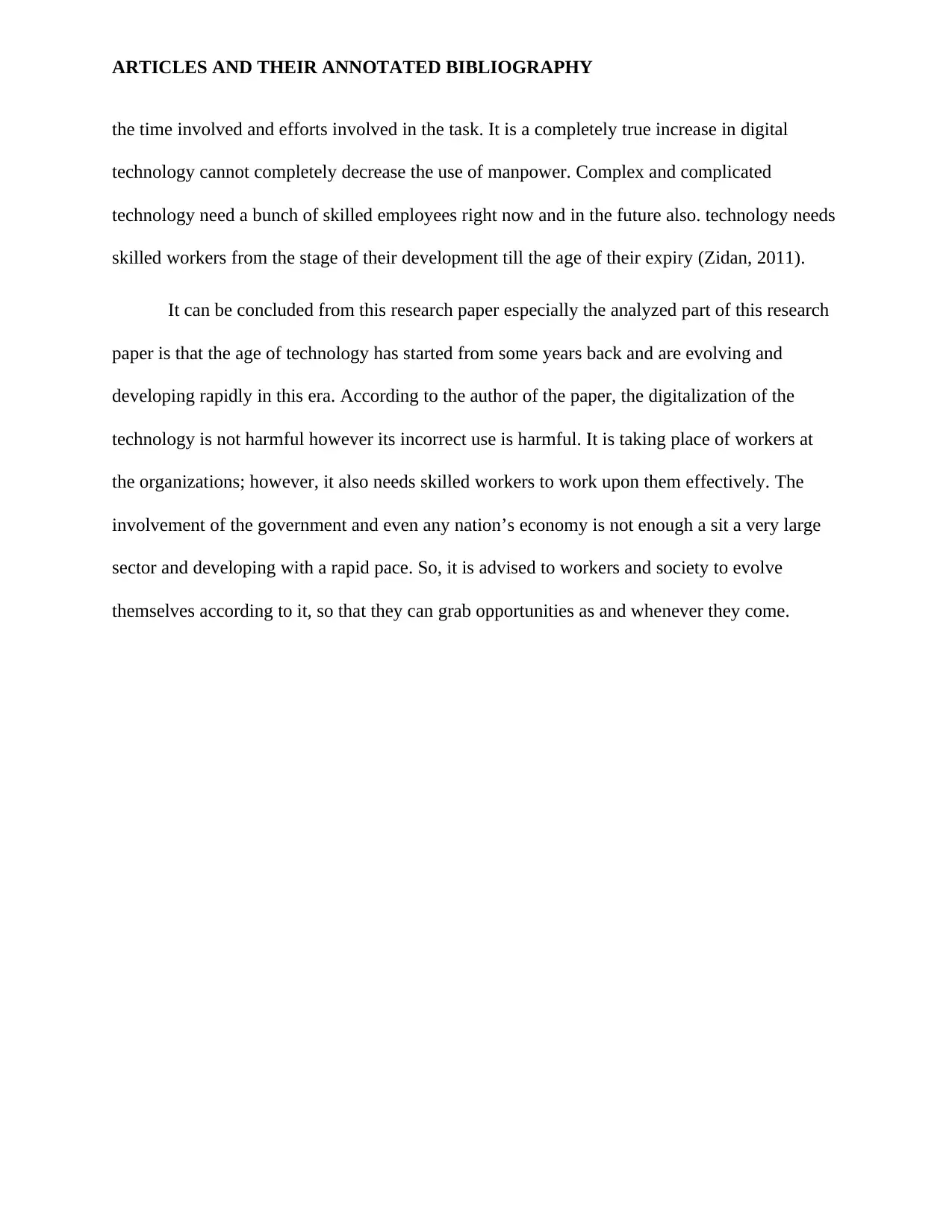
ARTICLES AND THEIR ANNOTATED BIBLIOGRAPHY
the time involved and efforts involved in the task. It is a completely true increase in digital
technology cannot completely decrease the use of manpower. Complex and complicated
technology need a bunch of skilled employees right now and in the future also. technology needs
skilled workers from the stage of their development till the age of their expiry (Zidan, 2011).
It can be concluded from this research paper especially the analyzed part of this research
paper is that the age of technology has started from some years back and are evolving and
developing rapidly in this era. According to the author of the paper, the digitalization of the
technology is not harmful however its incorrect use is harmful. It is taking place of workers at
the organizations; however, it also needs skilled workers to work upon them effectively. The
involvement of the government and even any nation’s economy is not enough a sit a very large
sector and developing with a rapid pace. So, it is advised to workers and society to evolve
themselves according to it, so that they can grab opportunities as and whenever they come.
the time involved and efforts involved in the task. It is a completely true increase in digital
technology cannot completely decrease the use of manpower. Complex and complicated
technology need a bunch of skilled employees right now and in the future also. technology needs
skilled workers from the stage of their development till the age of their expiry (Zidan, 2011).
It can be concluded from this research paper especially the analyzed part of this research
paper is that the age of technology has started from some years back and are evolving and
developing rapidly in this era. According to the author of the paper, the digitalization of the
technology is not harmful however its incorrect use is harmful. It is taking place of workers at
the organizations; however, it also needs skilled workers to work upon them effectively. The
involvement of the government and even any nation’s economy is not enough a sit a very large
sector and developing with a rapid pace. So, it is advised to workers and society to evolve
themselves according to it, so that they can grab opportunities as and whenever they come.
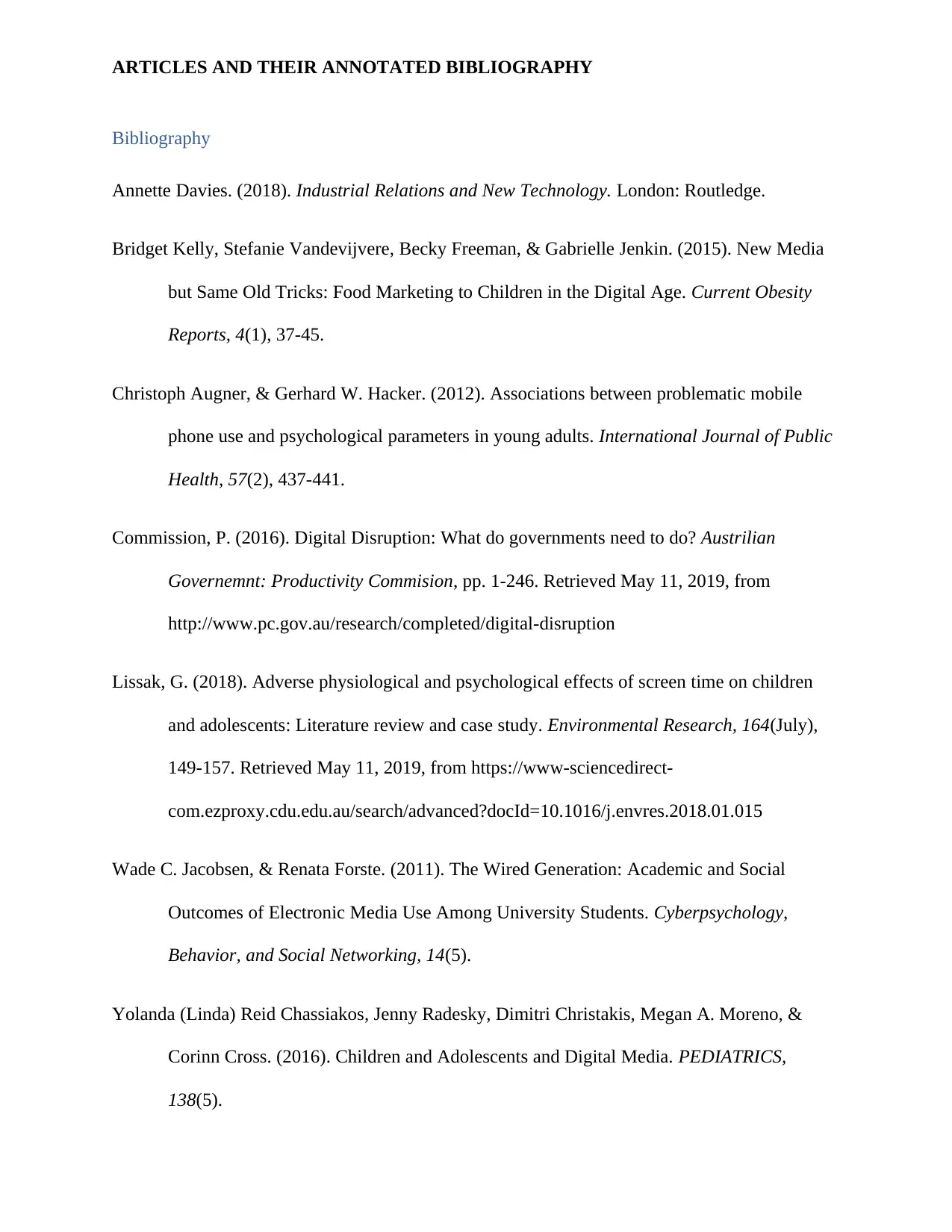
ARTICLES AND THEIR ANNOTATED BIBLIOGRAPHY
Bibliography
Annette Davies. (2018). Industrial Relations and New Technology. London: Routledge.
Bridget Kelly, Stefanie Vandevijvere, Becky Freeman, & Gabrielle Jenkin. (2015). New Media
but Same Old Tricks: Food Marketing to Children in the Digital Age. Current Obesity
Reports, 4(1), 37-45.
Christoph Augner, & Gerhard W. Hacker. (2012). Associations between problematic mobile
phone use and psychological parameters in young adults. International Journal of Public
Health, 57(2), 437-441.
Commission, P. (2016). Digital Disruption: What do governments need to do? Austrilian
Governemnt: Productivity Commision, pp. 1-246. Retrieved May 11, 2019, from
http://www.pc.gov.au/research/completed/digital-disruption
Lissak, G. (2018). Adverse physiological and psychological effects of screen time on children
and adolescents: Literature review and case study. Environmental Research, 164(July),
149-157. Retrieved May 11, 2019, from https://www-sciencedirect-
com.ezproxy.cdu.edu.au/search/advanced?docId=10.1016/j.envres.2018.01.015
Wade C. Jacobsen, & Renata Forste. (2011). The Wired Generation: Academic and Social
Outcomes of Electronic Media Use Among University Students. Cyberpsychology,
Behavior, and Social Networking, 14(5).
Yolanda (Linda) Reid Chassiakos, Jenny Radesky, Dimitri Christakis, Megan A. Moreno, &
Corinn Cross. (2016). Children and Adolescents and Digital Media. PEDIATRICS,
138(5).
Bibliography
Annette Davies. (2018). Industrial Relations and New Technology. London: Routledge.
Bridget Kelly, Stefanie Vandevijvere, Becky Freeman, & Gabrielle Jenkin. (2015). New Media
but Same Old Tricks: Food Marketing to Children in the Digital Age. Current Obesity
Reports, 4(1), 37-45.
Christoph Augner, & Gerhard W. Hacker. (2012). Associations between problematic mobile
phone use and psychological parameters in young adults. International Journal of Public
Health, 57(2), 437-441.
Commission, P. (2016). Digital Disruption: What do governments need to do? Austrilian
Governemnt: Productivity Commision, pp. 1-246. Retrieved May 11, 2019, from
http://www.pc.gov.au/research/completed/digital-disruption
Lissak, G. (2018). Adverse physiological and psychological effects of screen time on children
and adolescents: Literature review and case study. Environmental Research, 164(July),
149-157. Retrieved May 11, 2019, from https://www-sciencedirect-
com.ezproxy.cdu.edu.au/search/advanced?docId=10.1016/j.envres.2018.01.015
Wade C. Jacobsen, & Renata Forste. (2011). The Wired Generation: Academic and Social
Outcomes of Electronic Media Use Among University Students. Cyberpsychology,
Behavior, and Social Networking, 14(5).
Yolanda (Linda) Reid Chassiakos, Jenny Radesky, Dimitri Christakis, Megan A. Moreno, &
Corinn Cross. (2016). Children and Adolescents and Digital Media. PEDIATRICS,
138(5).
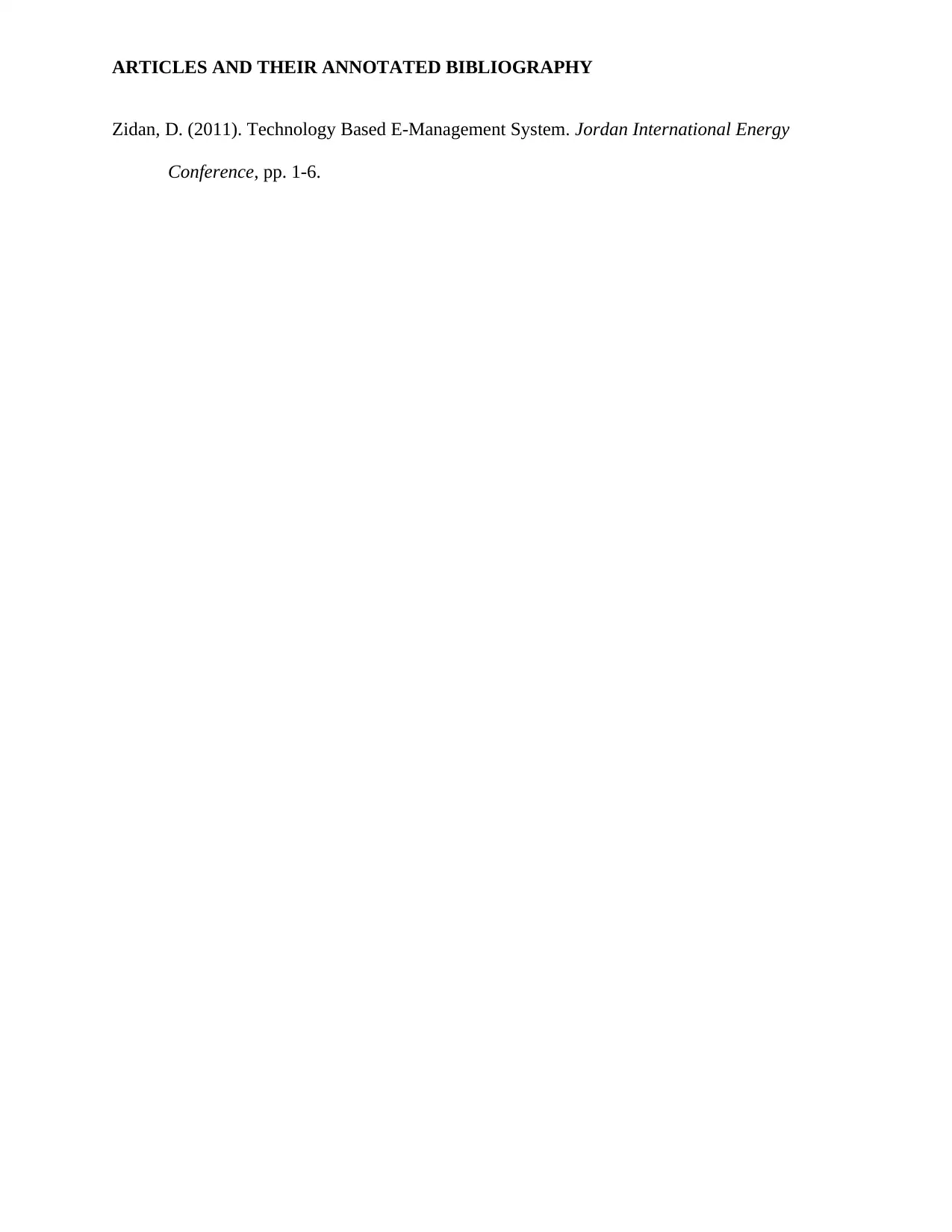
ARTICLES AND THEIR ANNOTATED BIBLIOGRAPHY
Zidan, D. (2011). Technology Based E-Management System. Jordan International Energy
Conference, pp. 1-6.
Zidan, D. (2011). Technology Based E-Management System. Jordan International Energy
Conference, pp. 1-6.
1 out of 7
Related Documents
Your All-in-One AI-Powered Toolkit for Academic Success.
+13062052269
info@desklib.com
Available 24*7 on WhatsApp / Email
![[object Object]](/_next/static/media/star-bottom.7253800d.svg)
Unlock your academic potential
© 2024 | Zucol Services PVT LTD | All rights reserved.





